Europe

 Captain Charles Wilkes was an American naval officer, ship’s captain, and explorer. During an exploring expedition, authorized by the May 18, 1836 act of the Congress, Wilkes set out to explore the southern oceans. Congress didn’t expect his expedition to find anything amazing, but that is where they were wrong. His group set out in 1838, and it was during this expedition that Wilkes spotted the coast of Antarctica. The group had sailed around South America to the South Pacific, and after spotting Antarctica, decided to explore a 1,500 mile stretch of it’s eastern coast. The area later became known a Wilkes Land. In 1842, the expedition returned to New York, after having circumnavigated the globe. Wilkes wasn’t the first explorer to look at Antarctica, however. It was discovered by European and American explorers, and in the February 1821, American John Davis became the first person to land on the continent, coming in at Hughes Bay on the Antarctic Peninsula.
Captain Charles Wilkes was an American naval officer, ship’s captain, and explorer. During an exploring expedition, authorized by the May 18, 1836 act of the Congress, Wilkes set out to explore the southern oceans. Congress didn’t expect his expedition to find anything amazing, but that is where they were wrong. His group set out in 1838, and it was during this expedition that Wilkes spotted the coast of Antarctica. The group had sailed around South America to the South Pacific, and after spotting Antarctica, decided to explore a 1,500 mile stretch of it’s eastern coast. The area later became known a Wilkes Land. In 1842, the expedition returned to New York, after having circumnavigated the globe. Wilkes wasn’t the first explorer to look at Antarctica, however. It was discovered by European and American explorers, and in the February 1821, American John Davis became the first person to land on the continent, coming in at Hughes Bay on the Antarctic Peninsula.
Over the next century, many nations, including the United States, wanted to stake their territorial claims to portions of the frigid continent. I’m sure they all had the same idea for its use. Obviously, it was not going to be a place where people were going to live for any length of time…at least not at first. Scientists do spend quite a bit of time there now, but back then, the necessary facilities and equipment were not available.
Finally, in the 1930s, conflicting claims finally led to international rivalry, and the United States, which led the world in the establishment of scientific bases, enacted an official policy of making no territorial claims while recognizing no other nation’s claims. While it didn’t immediately solve the conflict then, it probably set in 
 motion, the 1959 Antarctic Treaty that made Antarctica an international zone, set guidelines for scientific cooperation, and prohibited military operations, nuclear explosions, and the disposal of radioactive waste on the continent. It’s sometimes strange to think about a continent that has really no owner, or rather is owned by the world, and yet even in modern times we have another such place…the International Soace Station. It’s nice to know that there are some things that we can share globally and actually get along.
motion, the 1959 Antarctic Treaty that made Antarctica an international zone, set guidelines for scientific cooperation, and prohibited military operations, nuclear explosions, and the disposal of radioactive waste on the continent. It’s sometimes strange to think about a continent that has really no owner, or rather is owned by the world, and yet even in modern times we have another such place…the International Soace Station. It’s nice to know that there are some things that we can share globally and actually get along.
 Imagine charging a horse with murder, reckless endangerment, or vandalism for things like bucking its rider off, causing death or injury, or kicking the neighbors fence down. Insane, right…wrong!! For centuries, animals, including insects faced criminal charges across many parts of Europe. Now, I personally think that most insects need to be executed…no trial necessary!! The earliest documented case was a pig, who after being found guilty, was executed at Fontenay-aux-Roses in 1266. At that time it was believed that animals knew right from wrong, like humans do. I don’t think they were far off, because animals do seem to know when they have done something wrong, but I’m not sure that they understand guilt over of an accidental death or injury.
Imagine charging a horse with murder, reckless endangerment, or vandalism for things like bucking its rider off, causing death or injury, or kicking the neighbors fence down. Insane, right…wrong!! For centuries, animals, including insects faced criminal charges across many parts of Europe. Now, I personally think that most insects need to be executed…no trial necessary!! The earliest documented case was a pig, who after being found guilty, was executed at Fontenay-aux-Roses in 1266. At that time it was believed that animals knew right from wrong, like humans do. I don’t think they were far off, because animals do seem to know when they have done something wrong, but I’m not sure that they understand guilt over of an accidental death or injury.

Nevertheless, these trials went on as part of several legal systems until the 18th century. Animal defendants appeared before both church and secular courts, and the charges ranged from murder to criminal damage. Human witnesses were often heard and in Ecclesiastical courts the animals were routinely provided with lawyers. If convicted, the animal was usually executed or exiled. Several books were written about these trials. E.P. Evans’ The Criminal Prosecution and Capital Punishment of Animals, published in 1906, and Sadakat Kadri’s The Trial: Four Thousand Years of Courtroom Drama were two such books. Kadri shows that the trials were part of a broader phenomenon that saw corpses and inanimate objects also face prosecution…which takes weird to a completely new level. Some people think that modern day punishment of children and the mentally ill is rather an echo of those strange earlier rituals.
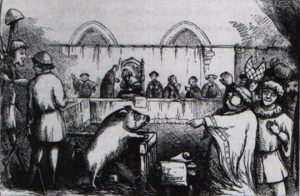
Several thoughts have come to my mind concerning these animal trials. For instance, animals can’t talk, so how were they supposed to testify or speak in their own defense? Also, were these trials held in a courtroom or a stable…for obvious reasons? And, if the offending animal belonged to someone, not the person who was the victim, how were they compensated for the loss of their animal? After all, they didn’t commit the “crime” that their animal was accused of. This is such a strange practice, that I have to wonder who came up with the idea originally anyway, and were they sane…or more likely insane.
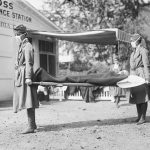
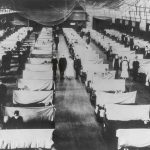 Not everyone agrees with getting the flu shot, and I get that. Still, even though there have been issues with the flu shot, it has also been something, along with medicines that has helped to prevent breakouts like the flu pandemic that hit Philadelphia on this day, September 28, 1918. It is believed that a Liberty Loan parade prompted the outbreak in Philadelphia, and before the outbreak was over, an estimated 30 million people worldwide were dead. As most of us know, influenza is a virus that attacks the respiratory system, is highly contagious, and mutates very quickly to avoid being killed by the human immune system. A prior pandemic of the flu in 1889 killed thousands all over the world, but it was nothing like the 1918 Flu Pandemic in its deadliness.
Not everyone agrees with getting the flu shot, and I get that. Still, even though there have been issues with the flu shot, it has also been something, along with medicines that has helped to prevent breakouts like the flu pandemic that hit Philadelphia on this day, September 28, 1918. It is believed that a Liberty Loan parade prompted the outbreak in Philadelphia, and before the outbreak was over, an estimated 30 million people worldwide were dead. As most of us know, influenza is a virus that attacks the respiratory system, is highly contagious, and mutates very quickly to avoid being killed by the human immune system. A prior pandemic of the flu in 1889 killed thousands all over the world, but it was nothing like the 1918 Flu Pandemic in its deadliness.
It is thought that the 1918 flu pandemic originated with a bird or farm animal in the American Midwest early that year. It may have traveled among birds, pigs, sheep, moose, bison, and elk, eventually mutating to the version that took hold in the human population that year. Like most outbreaks, this one started slowly, but as people moved from place to place, and others came in to help, it began to spread like wildfire. Once it spread to Europe later in the year, through some of the 200,000 American troops shipped out to fight in World War I, it was out of control. It affected every area of life, and people wore masks to avoid contact with the virus.
By June 1918, it had largely disappeared in North America, but only after taking a considerable toll on the people. Over the summer of 1918, it spread quickly over Europe. It’s first stop seems to have been in Spain, and it took so many lives there, that it was named the Spanish Flu. This flu was highly unusual, because it seemed to affect strong people in the prime of their lives rather than babies and the elderly. By the end of the summer, about 10,000 people were dead. In most cases, hemorrhages in the nose and lungs killed victims within three days. By fall, it was completely out of control. By the time it reached London and Boston in 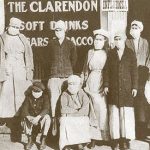
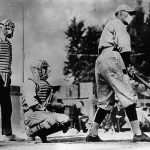 September, it was a far worse strain that it had been before. Twelve thousand soldiers came down with the flu in Massachusetts in mid-September. Philadelphia was the hardest hit city in the United States with a loss of nearly 12,000. The whole city was quarantined. In the United States, five out of every thousand people fell victim to the flu. Other countries were far worse, some as much as ten, fifteen or even thirty five per thousand, with 20 million people dying in India alone. In the end, more people died from the influenza pandemic, than from all of the battles of World War I combined.
September, it was a far worse strain that it had been before. Twelve thousand soldiers came down with the flu in Massachusetts in mid-September. Philadelphia was the hardest hit city in the United States with a loss of nearly 12,000. The whole city was quarantined. In the United States, five out of every thousand people fell victim to the flu. Other countries were far worse, some as much as ten, fifteen or even thirty five per thousand, with 20 million people dying in India alone. In the end, more people died from the influenza pandemic, than from all of the battles of World War I combined.
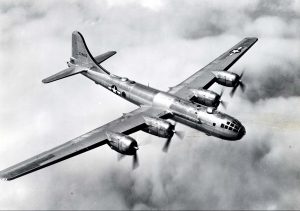 Since my dad was in the Army Air Forces in World War II, the B-17 is a plane that I have researched, watched documentaries and movies about, and toured. The B-17 was called the Flying Fortress, and my dad always said that it was a very safe plane. Nevertheless, as much as I love the B-17 Bomber, there are other war planes that were also stars of World War II. Sometimes, I think that I forget about all those others planes.
Since my dad was in the Army Air Forces in World War II, the B-17 is a plane that I have researched, watched documentaries and movies about, and toured. The B-17 was called the Flying Fortress, and my dad always said that it was a very safe plane. Nevertheless, as much as I love the B-17 Bomber, there are other war planes that were also stars of World War II. Sometimes, I think that I forget about all those others planes.
One of those planes, the B-29 Superfortress actually made its debut flight in Seattle Washington on this day, September 21, 1942. The B-29 was the largest bomber used in World War II, by any nation. The B-29 was the brain child of General Hap Arnold, back in 1939. Arnold worried that a German victory in Europe would mean the United States would have no bases on the eastern side of the Atlantic from which to counterattack. They needed a plane that could travel faster, farther, and higher than anything that was available then. Taking on the challenge, Boeing set out to create such a plane.
The plane they came up with was amazing. It could carry loads that were nearly its own weight and at altitudes  of 30,000 to 40,000 feet. The plane boasted a pilot console in the rear of the plane, capable of running the plane in the event the front pilot was knocked out of commission. It also had the first radar bombing system of any US bomber. While the Superfortress first took flight on September 21, 1942, it would not make its bombing debut until June 5, 1944, in a battle against Bangkok, as the Allies prepared to liberate Burma from the hands of the Japanese. Then a little over a week later, it was used against mainland Japan on June 14, when 60 B-29s based in Chengtu, China were used to bomb an iron and steel works factory on Honshu Island. It wasn’t exactly a successful mission, but it did boost the morale of the Americans.
of 30,000 to 40,000 feet. The plane boasted a pilot console in the rear of the plane, capable of running the plane in the event the front pilot was knocked out of commission. It also had the first radar bombing system of any US bomber. While the Superfortress first took flight on September 21, 1942, it would not make its bombing debut until June 5, 1944, in a battle against Bangkok, as the Allies prepared to liberate Burma from the hands of the Japanese. Then a little over a week later, it was used against mainland Japan on June 14, when 60 B-29s based in Chengtu, China were used to bomb an iron and steel works factory on Honshu Island. It wasn’t exactly a successful mission, but it did boost the morale of the Americans.
The United States recaptured the Marianas Islands in the South Pacific, because they were the perfect location for air bases for the new B-29s to strike mainland Japan on a consistent basis. When the bases were up and  running, they were used to coordinate a series of bombing raids against Tokyo. While the B-29s were capable of precision bombing at high altitudes, they began dropping incendiary devices from a mere 5,000 feet, firebombing the Japanese capital attempting to break the will of the Axis power. One raid, in March 1945, killed more than 80,000 people. But for the Superfortress, the most famous use would happen in August. It was the only plane capable of delivering a 10,000 pound bomb…the atomic bomb. The Enola Gay took off on August 6th and the Bock’s Car took off on August 9th both from the Marianas, and flew into history. Of course, we all hope that such a bomb run would never be necessary again, but if it had been, it was good to know it was available.
running, they were used to coordinate a series of bombing raids against Tokyo. While the B-29s were capable of precision bombing at high altitudes, they began dropping incendiary devices from a mere 5,000 feet, firebombing the Japanese capital attempting to break the will of the Axis power. One raid, in March 1945, killed more than 80,000 people. But for the Superfortress, the most famous use would happen in August. It was the only plane capable of delivering a 10,000 pound bomb…the atomic bomb. The Enola Gay took off on August 6th and the Bock’s Car took off on August 9th both from the Marianas, and flew into history. Of course, we all hope that such a bomb run would never be necessary again, but if it had been, it was good to know it was available.
 When I come across a husband and wife, who both died on the same day, my curiosity kicks into overdrive. That just seems so unusual. Nevertheless, such was the case for my husband, Bob’s 4th great grandparents, Cloudsbury and Elizabeth Kirby, both of whom died on August 29, 1878 in Mount Ayr, Ringgold County, Iowa. At first, I wondered if it was an error, and I suppose it could be, but that is the information I have at this point, so that is what I have to go with.
When I come across a husband and wife, who both died on the same day, my curiosity kicks into overdrive. That just seems so unusual. Nevertheless, such was the case for my husband, Bob’s 4th great grandparents, Cloudsbury and Elizabeth Kirby, both of whom died on August 29, 1878 in Mount Ayr, Ringgold County, Iowa. At first, I wondered if it was an error, and I suppose it could be, but that is the information I have at this point, so that is what I have to go with.
My first thought was to check for disasters in the area, like tornados, fires, or floods, but I was unable to find anything that specifically happened in Mount Ayr, Iowa on August 29, 1878. Looking for these kinds of specific things can be a long and frustrating process, but I just can’t imagine too many situations where both halves of a couple would pass on the same day. I searched and found that there were tornadoes during that year, but nothing specifically on that day, so I doubt that a tornado is the culprit here.
When the possibility of a disaster was removed, I began to think about illness, so I looked up and epidemics in the area. That is when I came across a definite possibility…the Yellow Fever Epidemic of 1876 to 1878, which took many lives in the southern United States. Yellow fever, known historically as yellow jack or yellow plague is an acute viral disease, that is usually spread by the female mosquito. Symptoms include fever, chills, loss of appetite, nausea, muscle pains particularly in the back, and headaches. Many people improve after a few days, but when the symptoms return, they can cause kidney damage, liver failure (causing yellow skin, probably the reason for the name Yellow Fever), bleeding, and ultimately death. These days there is a vaccine against Yellow Fever and some countries require it for travelers. Other countries try to control the virus by killing off as many mosquitoes as possible. Nevertheless, Yellow Fever causes 200,000 infections and 30,000 deaths every year with nearly 90% of those occurring in Africa, these days. Since the 17th century, several major outbreaks have occurred in America, Africa, and Europe. In the 18th and 19th centuries yellow fever was seen as the most dangerous of infectious diseases.
I can’t say for sure that Yellow Fever is what took the lives of Bob’s 4th great grandparents, but with the epidemic that occurred during that time, I have to think that it is a possibility. I have looked at the lists of people know to have died of Yellow Fever during that epidemic, and did not see Cloudsbury and Elizabeth Kirby on the list, but the list was incomplete, with many people only listed as a number. At this time, unless more information somehow surfaces, I will probably never know for sure, but the epidemic, which apparently came in from Cuba caused 100,000 people to become ill, and killed 20,000 people, so it is likely that they were too busy, trying to help people get better, to keep really great records as to the names of the dead. I have to feel really sorry for people of that time. They didn’t really know what was causing the epidemic and would not have had a way to do much about it anyway, so many lives were lost. Thankfully for the people of this century, Yellow Fever can be prevented by vaccination, and it is usually found in Africa, so we don’t really see much of it here.
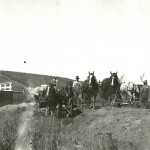
 I never knew my Great Grandpa Byer, because he passed away in 1930, long before I was born. Most of what I know of him comes from my genealogy research, pictures I have found, and the stories I have heard from my mom. The first time I remember hearing about him was when I gave birth to my oldest daughter, Corrie. My mother mention that I might want to name her Cornelia, so that it would be after her great great grandpa. I was not willing to go so far as to change the name I had chosen, but the name did attach itself to Corrie anyway, in the form of a nickname…that I loved, by the way.
I never knew my Great Grandpa Byer, because he passed away in 1930, long before I was born. Most of what I know of him comes from my genealogy research, pictures I have found, and the stories I have heard from my mom. The first time I remember hearing about him was when I gave birth to my oldest daughter, Corrie. My mother mention that I might want to name her Cornelia, so that it would be after her great great grandpa. I was not willing to go so far as to change the name I had chosen, but the name did attach itself to Corrie anyway, in the form of a nickname…that I loved, by the way.
My research told me that my great grandfather was born in Russia, which very much surprised me, as I thought that part of the family came from Germany. My mother filled in the blanks there, by telling me that in the 1780’s, my 6th great grandfather, who was concerned because of wars in Europe, and wanting to keep his family, and especially his son safe from the increasing German interest in jumping into the war. So, he moved his family to Russia, where my part of the family would live until, my great grandfather’s family immigrated to the United States. He eventually settled in South Dakota, where he married my great grandmother.
Picture documentation, at the point, places my great grandparents on a homestead in Nebraska. During his time in South Dakota and Nebraska, he befriended many of the Indians in the area. He was well respected by them and was invited to their Pow Wow’s. It is at this point in the family history that I came across another picture that made me wonder about its inclusion in the other family pictures. It still seems odd to me, but my mom assures me with her story, that it indeed fits in the family history. The picture is of a group of men in a pool hall. When I asked mom about the picture, she told me that she didn’t know the men in the picture, but the pool hall 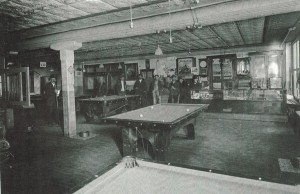 had belonged to her grandfather. I am still trying to figure out how he went from homesteading to a pool hall owner, but that is what he did. I’m sure that like most career changes, the decision was based on the income possibilities, because the main thing is to be able to support your family. The pool hall is not surprising to me because of what it was, but because of the fact that he had been a homesteader and farmer by trade for so long. Things change, as the needs change, and that is as simple as that. He saw a way to make a living, or even supplement the family income, and he did it. It is an interesting twist to my history.
had belonged to her grandfather. I am still trying to figure out how he went from homesteading to a pool hall owner, but that is what he did. I’m sure that like most career changes, the decision was based on the income possibilities, because the main thing is to be able to support your family. The pool hall is not surprising to me because of what it was, but because of the fact that he had been a homesteader and farmer by trade for so long. Things change, as the needs change, and that is as simple as that. He saw a way to make a living, or even supplement the family income, and he did it. It is an interesting twist to my history.

 Most of us have a teacher that we would have to call our favorite of all the teachers we ever had, and I am no exception, but this story is about the favorite teacher I never had. You see, I couldn’t have had this teacher, because by the time she was born, I was already out of school. My favorite teacher I never had is my niece, Liz. I can’t say that I know anything about her teaching style, and I suppose you could call me biased, and you would be right, but she is nevertheless, my favorite.
Most of us have a teacher that we would have to call our favorite of all the teachers we ever had, and I am no exception, but this story is about the favorite teacher I never had. You see, I couldn’t have had this teacher, because by the time she was born, I was already out of school. My favorite teacher I never had is my niece, Liz. I can’t say that I know anything about her teaching style, and I suppose you could call me biased, and you would be right, but she is nevertheless, my favorite.
Liz is also the favorite of many of her students, and when they leave her class, most are friends for life. Her students friend her on Facebook, and even go on trips with her later. She has traveled with one student’s family to Europe, and everyone had a wonderful time. Liz is simply a friend to all. And is loved by all who know her.
I know that her teaching style is great, because you don’t like a teacher who makes class boring, or is just a bad teacher in general. I do know that while she maintains an orderly class, it is also somewhat laid back. Maybe that is why her students work so hard for Liz. They try to excel. That is a quality that is so important in teaching. You have to be able to inspire your students. That is what Liz does.
As I have watched Liz through her years of teaching, I have found myself amazed at the love her students feel for her. I rarely heard of that before I began watching Liz do her teaching thing. Most kids, even if they liked their teacher, were still done with the teachers after school was over. And almost no one wants to spend time with the teachers after school is over…except Liz’s students. I think that is wonderful.
Liz is also the photographer for events, sports, the school paper, and the annual. That is a big responsibility, and yet a lot of fun, because she has the unique ability to get to know students that aren’t even in her classes. She is careful to include every student in the school annual, and as many other events as she possible can. Those kids couldn’t have a better photographer…I know, because she has done pictures of my family too, as well as my grandson and other family members in the school activities. Yes, she has taught her cousins and nieces and nephews…and they still love her too.

Yes, I am biased, but Liz is still my favorite teacher, even though I never had her as a teacher. She is a different kind of teacher…one who really cares about her students, and that is awesome…as any of her students would tell you. And having someone in this world who cares about someone they aren’t related to, teacher or otherwise is rare indeed. Happy birthday Liz!! We all love you!!
 Very early on, Elizabeth, Liz as we all call her, displayed a determination that not every child has. She had decided that she was going places, and she set out to go there. Liz studied hard and began weighing her options, deciding what she wanted to do with her life.
Very early on, Elizabeth, Liz as we all call her, displayed a determination that not every child has. She had decided that she was going places, and she set out to go there. Liz studied hard and began weighing her options, deciding what she wanted to do with her life.
She set her sights on teaching English, but her counselor said that she would do better in Journalism, so she got a Journalism degree, but her heart was still in the classroom. So, she continued on another year to get her degree in education, and returned to Casper to begin her career. Her skills would land her the jobs of the school newspaper, the annual, and photographing most events. Her work was flawless.
Her students loved her, and quickly gave her the nickname Mast. The end of their high school days would not mean the end of their friendship with their beloved teacher. They invited her on trips to Vegas and Europe. They wanted to stay connected to the treasured teacher who had become not only an inspiration to them during their high school days, but a lifelong friend. How many of us can say that after high school, we wanted to stay friends with our teachers. Even the teachers we liked faded into the distance as we left the walls of high school behind, but not so with Liz…or Mast. I see the comments her past students make to her on Facebook, and hear the love in their voices when she runs into one of them in town. A student sees her and excitedly yells out, “Mast!!” Then the chatter begins. “Guess what I did!!” “You would be so proud of me…I did this.” “I’m going to this school.” And so on. I have to say that it makes me proud to be her aunt when these young adults, whose lives she has helped to shape, excitedly gather around the teacher whose class they loved, and tell her about their future plans. The want her to be a part of it. After all, she helped start it.
Of course, being a teacher isn’t all Liz is about. She is Aunt Liz to her sisters’ and brother’s children, and they love her dearly…no matter how old they get. They love being around her, as do her cousins, and her aunts, uncles, and grandmother…not to mention her mom and sisters and brother and their families. Liz is a fun person to be around. Not everyone has that ability. She is a very special part of this family.
And last, but certainly not least, is her ability to photograph the moments of life. She captures the essence of the moment better than so many people could ever do. Her pictures are stunning, funny, beautiful, exciting, sad, goofy, or shocked, depending on what is going on at that moment. She has documented some of the most important moments in the lives of family and friends, and given them the memories that they couldn’t have had any other way…because she does it with love. No matter who she is photographing, she thinks about what they will want to remember about the moment, and gives them just that.
and given them the memories that they couldn’t have had any other way…because she does it with love. No matter who she is photographing, she thinks about what they will want to remember about the moment, and gives them just that.
There is so much more I could say about Liz, but anyone who knows her, already knows these things. She has made her mark on this place, and it will never be the same again, because she left each moment better than she found it. And because of who she is, she will keep doing that for the next students, and for the family too. I love you Liz, and I’m very proud of all you have accomplished!!

